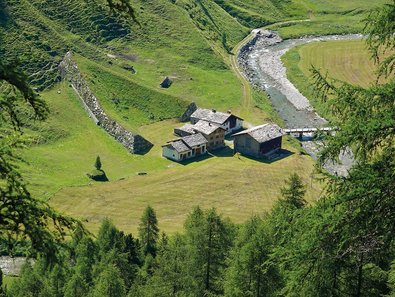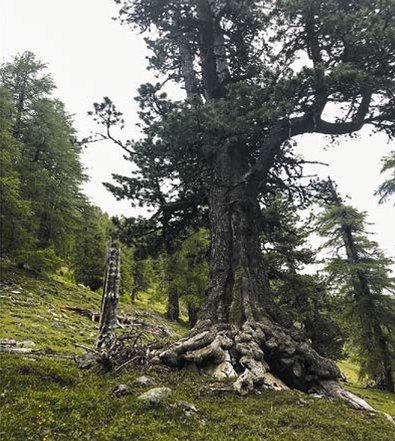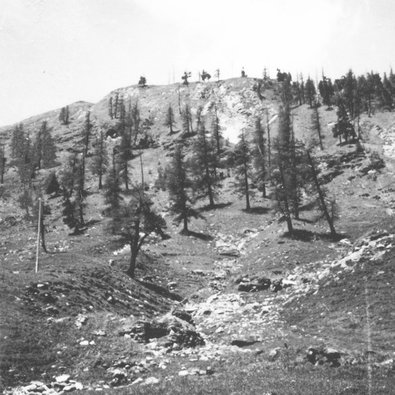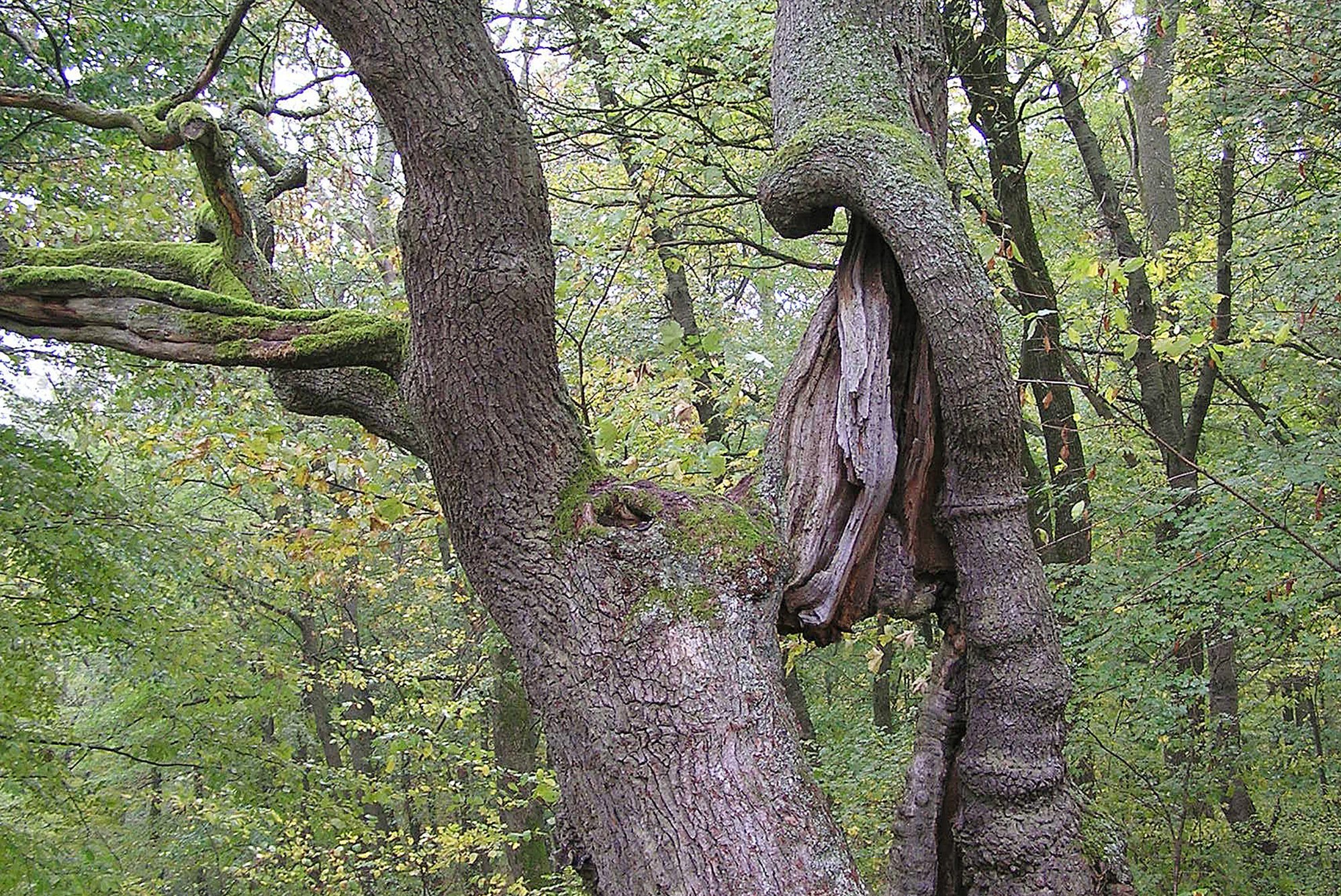At the end of the 13th century or in the first half of the 14th century, the Walser people settled in the high Alpine valley of Avers, in the Canton of the Grisons (Graubünden) in Switzerland. Their livestock and dairy farming activities shaped the landscape of the valley, as did its proximity to the northern Italian livestock markets on the other side of the Alps (over the Bocchetta da Lägh/Madriserberg mountain). In the course of mediaeval land seizures, the southwest-facing flank of the upper valley was cleared to create pastures and for the construction of dwellings and farm buildings. Today it is largely free of forest (fig. 1).

Fig. 1. The landscape of the Avers high valley is characterised by the meadows and pastures on one side of the valley, and forests full of old larch and stone pine trees on the opposite side. Photo: Susan Lock (WSL)
An ancient cultural landscape in transition
It was not until the construction of the valley road between 1890 and 1895 that the main economic orientation of the Avers valley turned from south to north. Until then, the lack of a road network made it difficult to transport timber and firewood into the valley for personal use. Only a little wood made it to the market. Road construction and, from the 1950s onwards, the spread of electricity and oil-fired heating systems, led to a sharp decline in the demand for firewood and thus forest utilisation.
The focus on livestock farming in the Avers valley meant that for a long time, the forests were subject to heavy grazing pressure. The practice of silvopasture is thus of key importance for the development of the forest structure in the Avers valley, and the people of Avers often found themselves at odds with the forestry service. Only after the Second World War was the grazing pressure on forest regeneration reduced as a result of a decrease in the number of goats, and the silvopasture became less intensive. Other forests uses such as the collection of litter, grass, resin and pine nuts, as well as berry-picking, the making of kindling from resinous pine wood, and moss-gathering, were once widespread. These uses have also declined over time.
500 years of forest dynamics
Vivid illustrations of the history of the landscape and utilisation of the Avers high valley are to be found in archives and old forest management plans, from oral sources and, from 1933, in aerial photographs. Terrestrial photographs show the forest from the human perspective. Serial photographs reveal the structural changes in the forest over time:
Changes and reductions in forest utilisation have allowed the open, light-flooded silvopasture forests to develop into dense, dark stands today, as in the Capettawald forest, which has not been grazed or utilised commercially for over 60 years (fig. 3.1-3). In the Cröterwald forest, by contrast, time has to a certain extent stood stilI. This forest is intensively grazed to this day (fig. 3.4-5), and the light conditions here nowadays remain similar to those of decades and centuries ago.
Stand dynamics
Fig. 4. Year of establishment of spruce (yellow), larch (orange) and Swiss stone pine (green) over 800 years in the Cröterwald, Hohenhauswald and Capettawald forests. Each box represents a sample plot, arranged from bottom to top along the height gradient. The percentage of the respective tree species per sample plot is shown in the pie chart. Source: Carella et al. (2022, modified)
The consequences of the changes in land use are clearly visible in the Hohenhaus and Capettawald forests, where new trees have become established over a wide area from the 20th century onwards (fig. 4). The broad absence of spruce in the Cröterwald and Hohenhauswald forests is presumably also due to past and current management measures. In the Cröterwald forest, there was no spurt in regeneration at the beginning of the 20th century - something which can be attributed primarily to the persistently high grazing pressure. This has allowed a stand of very old trees to develop, which for centuries have only been able to regenerate sporadically in places.
These impressive trees, some of which are centuries old, give us insights into the history of the forest. Their age has been determined on the basis of tree ring analyses. In all of the stands investigated in the Avers valley, samples were taken from trees that are very old (fig. 4). The monumental trees over 600 years old are exclusively stone pine and larch (fig. 5).
In the Cröterwald forest, there is no tree generation at all of medium age, and the regeneration is also only sparse. In the Capettawald and Hohenhauswald forests, where grazing was stopped decades ago, the old monumental trees are surrounded by sometimes very dense forest regeneration (fig. 6). At lower altitudes, the regeneration has already penetrated the canopy and is competing with the old trees. Competition for light is very fierce in some areas, and in the dark lower storey with a considerable layer of raw humus, the larch can barely take seed.
Fig. 6. Left: Old stone pines in the upper Capettawald forest, dominant single trees until a few years ago, increasingly face competition from younger trees. Right: Ancient, uprooted Swiss stone pine in the lower Capettawald forest. In today's dark stand, the larch can only regenerate in gaps and on rootstocks. Photos: Andreas Rigling (ETHZ)
Forest regeneration
A low crown cover is generally important for successful tree regeneration. In the open stands at the timberline, where grazing pressure is low and light availability is high, the regeneration will continue to be able to establish itself successfully in the future - dominated mainly by larch, with some stone pine and spruce. In the Cröterwald forest, the low number of trunks could mean that avalanches and sliding snow prevent regeneration from developing at the desired rate. At lower altitudes, high grazing pressure and the selective removal of regeneration in places prevent the emergence of young stands (fig. 7).
Fig. 7. Between the Hohenhauswald and Cröterwald forests (“Bim olta Hus” (“near the old house”)), the tree canopy on the upper part of the slope has become much more closed; the lower part is grazed. Photo left: SAGR C32.328/19 Forest Inspectorate, undated (pre-1940); right: Susan Lock (WSL, 2022)
In the Hohenhaus and Capettawald forests, the regeneration density (apart from the timberline) remains low due to the high crown canopy cover. As a strongly light-dependent species, larch in particular will hardly be able to regenerate in these now largely closed-canopy stands.
Tree growth
Summer temperatures are crucial for tree growth in stands at high altitude, as in the Avers valley. The larch in particular thus shows a strong increase in growth in all of the investigated stands since the 1980s. This is in line with the increasing temperatures as a result of climate change, although the absence of severe outbreaks of larch moth infestation since 1982 may also have contributed to this increase in growth. The situation is different for the Swiss stone pine, however, which has shown a trend towards negative growth at lower altitudes in recent decades, and a trend towards positive growth at higher altitudes (fig. 8).
This could indicate a sensitivity of the Swiss stone pine to warmer or possibly drier conditions. Irrespective of this, the two tree species larch and stone pine react very differently to the changing growth conditions. In the long term, this could have an influence on their competitiveness and ultimately on the future species composition of the forests in the Avers valley. Will the larch be able to spread at the expense of the Swiss stone pine thanks to its improved growth at low altitudes? If so, this would be of great significance for future forest dynamics in the upper subalpine altitudinal belt.
What does this mean for silviculture in the future?
Based on the forest development described, silvicultural measures can be taken to prolong the life of the ancient monumental trees, thereby securing the microhabitats important for biodiversity and preserving the structure of the semi-open silvopasture forests as a special feature of the cultural landscape. At the same time, the next generation of old trees should also be promoted, the conditions for regeneration should be improved, and the overall stability of these special forests increased:
- The number of trunks in the immediate vicinity of the ancient trees should be reduced in order to reduce the competition for the resources light and water. This is particularly important for the monumental stone pines at low elevations. Thinning to allow more light into the stand should be carried out at the latest when the young trees reach the crowns of the old trees.
- By means of targeted thinning measures, selected medium-aged trees should be promoted as “guarantors of stability”, in order to maintain stand stability in the medium term when the monumental old tree monuments begin to die.
- Given the great uncertainties with regard to the effects of climate change, tree species diversity should be increased where possible. In this context, spruce and for example also birch, rowan and aspen should be specifically included in the species mix in order to strengthen the resilience of the forests.
- The Cröter silvopasture forest is today considered to be an aesthetically pleasing and ecologically valuable cultural landscape. Its open structures should be preserved, but sustainability in terms of regeneration and the tree species mix should nevertheless also be ensured. This can and should happen, thanks to a forest pasture regime that allows grazing to continue.
- At lower altitudes in the Capettawald forest, where the trees are very vigorous, the stands increasingly dense and dark, and the humus layers ever thicker, the Swiss stone pine or at best the spruce will prevail in the long term. To keep the larch in the game, gaps can be opened up, and humus can be scraped away in places to expose the mineral soil it requires.
The proposed silvicultural planning aims to steer forest development in such a way that the expected challenges can be met, despite the uncertainties regarding climate change and future demand for forest services. It is based on an understanding of current forest dynamics in the light of past land use, taking into account local traditions and needs. Not directly taken into account are the costs incurred for silvicultural measures and who should ultimately bear them, and higher-ranking aims and social expectations, which are likely to have a decisive influence on the forest services demanded today and in the future.
The bottom line
Forest development and the history of forest utilisation are closely related - one cannot be understood without the other. What is fascinating about the study of these interrelationships based on the forests in the Avers valley is firstly that here they have led to significant consequences for the landscape, namely the restriction of the forest stands of the upper valley to one side of the valley. Secondly, when we visit these forests today, we are struck by the mighty, obviously very old larch and stone pine trees. Their occurrence is also a consequence of the interconnections between forest development and the history of utilisation.
The results presented here make it clear that the distribution of forest in the valley was very much determined by the demand for pasture and hay meadows. Not only were the most suitable areas completely cleared for this purpose, but the remaining forests on the opposite slope were also heavily grazed. For a long time, the high pressure of use allowed only little regeneration to emerge. This led to the development of a park-like, sparse forest structure in some places, as still visible today in the Cröterwald forest.
Information about the past does not permit direct conclusions about how it will be in the future, but it does show possible ways in which the landscape can be shaped in terms of its use and appearance.
Literature
Methodological notes and literature references can be found in the Original artice (PDF, in German).















